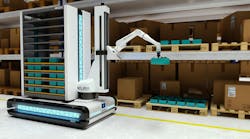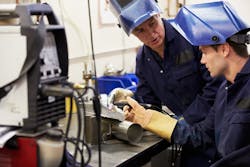In 2017, the Committee for Economic Development (CED) embarked upon a “listening tour” of business leaders and parents to discuss firsthand information about workplace demands and aspirations for high school graduates. The listening tour made stops in five communities over the course of a year: Oakland, Calif.; Westfield, Mass.; Tupelo, Miss.; Marysville, Ohio; and Norfolk, Va.
Manufacturing is one of the main industries represented in the communities selected for the study and is a field that employs high school graduates without a higher-education degree. CED brought business leaders and parents together to figure out how they could make students ready to enter in-demand fields such as manufacturing, directly out of high school.
Cindy Cisneros, vice president of education programs at CED, explains the methodology of the study and how both parents and business leaders can contribute to career readiness for high school students.
A builder on site discusses work with an apprentice. By 2020, 65% of all jobs in the economy are projected to require postsecondary education and training beyond high school.
How did CED choose the communities for the listening tour?
The five cities were chosen on the basis of achieving a diversity of geography, community demographics, and industry in which to conduct the focus group discussions. CED also drew from its broad network of member partners across the country to help identify sites. Invitations were extended to 10 business leaders who are representative of the regional economy, as well as 10 parents with children of varied age ranges from middle and high school.
The size of the group was kept intentionally small to allow for conversation among participants. The group was specifically designed to engage the two education key stakeholder groups of business leaders and parents and provide an opportunity to interact without the school as an intermediary.
An engineer teaches his student how to use a TIG welding machine. The skills gap can cost employers up to $23,000 a year per unfilled position.
What was the goal of each stop on the tour?
In each community, 90-minute sessions were structured to identify strategies for increasing the effectiveness of business engagement, and to identify the information and supports parents need to ensure student success in the workplace— and to leave each community with a potential path for continued dialogue. No community-level data, strategies, or initiatives related to education or workforce development were gathered or shared as part of the listening tour. Instead, the scope of the listening tour was deliberately narrowed to focus solely on community-based, community-driven insights and ideas.
Why does career readiness matter?
Career readiness has a long and somewhat complicated history in the United States. Following generations of pendulum swings from vocational tracking to college-for-all, recent years have seen an attempt to shift toward a more nuanced approach of preparing students for both college and a career.
Why this shift toward a middle ground? Despite some indications that our education system is improving following decades of standards-based reform, data show that too many young people in America are floundering. In the K-12 system, high school graduation rates are on the rise overall, yet attainment gaps persist: 88% of White students graduate within four years. However, their Black peers graduate at a rate of just 75%, and their Hispanic peers at a rate of 78%.
At the postsecondary level, standardized testing scores have been stagnant for the ACT and on the decline for the SAT. Once in college, nearly one-third of students report taking remedial coursework, and only 59% of undergraduates earn a Bachelor’s degree within six years.
A construction trainee learns technical skills on the job with her tutor. One report examining middle market companies found that 44% of executives report lacking candidates with the right skills.
Why do these figures matter?
By 2020, 65% of all jobs in the economy are projected to require postsecondary education and training beyond high school (35% at least a Bachelor’s degree, 30% some college or an Associate’s degree). Yet, if the attainment rates mentioned above hold steady, the supply of qualified candidates will fall short. Reports from employers already point to a skills gap, meaning a mismatch between the knowledge and skills of prospective employees and the competencies needed for available jobs.
One report examining middle market companies found that 44% of executives report lacking candidates with the right skills. And according to the latest jobs report, there are more jobs available than there are individuals unemployed. In addition, the skills gap can cost employers up to $23,000 a year per unfilled position.
What are the findings of the study?
There were striking similarities across the five communities from coast to coast when examining the goals and aspirations for students shared by parents and business leaders. In communities with a strong presence from the manufacturing industry, business leaders spent significant time during sessions sharing information about the programs in place. When asked about the goals and expectations for graduates right out of high school, both parents and business leaders shared the hope that graduates would enter the workforce as good citizens who are willing to learn.
However, there was one major disconnect: Parents said they want graduates to obtain professional/vocational education before entering the workforce, while business leaders want graduates to have strong communication and interpersonal skills, often referred to as “soft skills.” Business leaders stated they are prepared to teach the needed technical skills on the job or help students gain the necessary industry credentials. Additionally, a national study by CareerBuilder found that a large majority of employers (77%) believe that soft skills are just as important as technical, or hard skills.
Two students work together on an engine in mechanical school. A national study found that 77% of employers believe that soft skills are just as important as technical, or hard, skills.
How can parents and business leaders help students develop these soft skills before they enter the workforce?
Both groups brainstormed a number of strategies to help students refine their soft skills while simultaneously strengthening their technical skills. All five communities supported the notion of work-based learning as a key to success. Discussions focused on providing students with opportunities to experience the full continuum, beginning as early as elementary school: awareness, exploration, preparation, and training. For example, the Marysville, Ohio community agreed that they could help school adapt goals to provide exposure to a future work life by allowing businesses to host career fairs and provide internships to high school students.
There was a strong emphasis on how to provide students with the guidance, mentoring, and coaching needed to explore career pathways. Participants discussed the idea of a new type of staff position within schools, designed specifically to focus on career readiness, including serving as an intermediary for stakeholders while offering guidance to students.
Implementing these ideas must begin with coordination and communication between parents and the business community, as well as collaboration with schools, in order to give students what they need to find and keep good jobs once they cross the graduation stage and enter the workforce.















